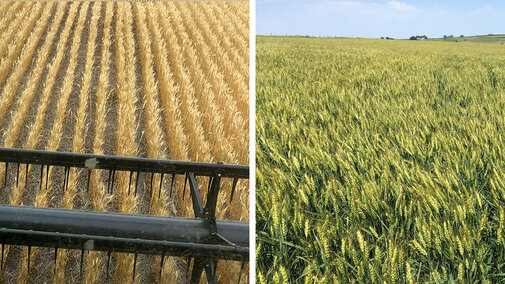The winter wheat yield across Nebraska is projected by USDA-NASS to be 48 bushels per acre, which is up 2 bushels from 2017, but down 6 bushels from 2016. However, 2018 wheat yields in eastern Nebraska were significantly lower compared to the past two years (Figure 1). Let’s break down this past growing season by crop reporting districts.
Northeast and East Central Nebraska
Wheat grown in these two districts (Figure 2) only makes up about 20% of the eastern Nebraska wheat acres. Overall, abnormally dry conditions were limited to the southern portion of the east central district during the growing season. Growers found wheat yields this July ranging from 40 to 80 bushels per acre for field averages with test weights of 56 to 62 pounds and protein from 12% to 14%. University of Nebraska Winter Wheat Variety Test results in Lancaster, Saunders, and Washington counties averaged 90 bushels per acre.

Looking back to the start of the season, above-average rainfall in early October delayed planting until the third and fourth week of October. An extremely dry November along with a colder than average first half of November combined with late planting led to reduced fall tillering. Soil moisture conditions were abnormally dry by December. Record cold temperatures in April significantly delayed development by two weeks, but a record hot May and hot June moved harvest back close to normal the second week of July. Daytime highs of over 100°F for several days at the end of May likely affected pollination and kernel abortion in the area.
“Lincoln experienced the coldest April and warmest May on record in 2018.”
Location: Lincoln Airport, 1948 – present
(Source: Nebraska Climate Office Monthly Reports)
Wheat was significantly shorter than in past growing seasons. Soil moisture was only a minor factor limiting growth in east central and northeast Nebraska. We know from past experience that late-planted wheat is likely going to be shorter. However, a combination of late planting, a very cold April followed by a hot May during vegetative growth/elongation likely led to the short-statured wheat crop. Unfortunately, heat stress, excessive rainfall, and too many cloudy days in June further reduced wheat yields. Though not common across the area, there was head shattering near Lincoln prior to harvest that impacted some varieties.
There was very little spring disease pressure and an absence of stripe rust unlike in the past several growing seasons. However, late season (after flowering) disease pressure from bacterial leaf streak, leaf rust, and Fusarium head blight was noticeable in June.
Southeast Nebraska
Wheat grown in the southeast district makes up nearly 80% of the eastern Nebraska wheat acres. Growers found variable and surprising wheat yields in mid-June and early July ranging from as little as 10 to over 80 bushels per acre for field averages, decent test weights of 58 to 60 pounds and protein of 11% to 15% (Nebraska Wheat Board Reports). In Gage, Jefferson and Saline County yields ranged from 30 to 60 bushels per acre depending on the sparse rain events in May and June. Several reports came in with protein levels of 14% and above at harvest, which was attractive to the milling markets with premiums being paid. Some good wheat yields of 60 to 70 bushels per acre were reported in areas of Nemaha and Pawnee counties, with one field under intensive management at over 80 bu/ac. Lower yields were generally reported form Nuckolls and Thayer counties. University of Nebraska Winter Wheat Variety Test results in Jefferson and Clay counties averaged 55 bushels per acre between the two trials.
Fall weather and challenges faced the southeast Nebraska wheat crop like that in east central and northeast Nebraska. The record cold April did cause some leaf damage to wheat. The abnormally dry conditions in March led to moderate drought (D1) conditions during May and June (US Drought Monitor scale), especially in the counties bordering the Kansas line. Wheat was showing moisture stress with a blue-gray color and lower leaves turning brown already in early May (Figure 3). By early June, some growers in the southwest portion of southeast Nebraska had decided to abandon grain harvest on some acres and start baling.

Wheat diseases were only a minor factor throughout the growing season. Early season diseases including tan spot and powdery mildew were identified in early May. Late-season diseases were not much of an issue due to drought and early maturity with harvesting starting the third week of June.
Stay Informed
Eastern Nebraska winter wheat growers stay connected and up-to-date throughout the season through an email group started earlier this year: the easternnewheat@listserv.unl.edu. They can correspond with and learn from each other while getting timely news for their operation from Nebraska Extension.
Here's more info and how to join.
Wheat Variety Field Trial Results
Results from the university's 2018 Winter Wheat Variety Trials are posted to the Web as they become available.
CropWatch Articles about Wheat in Eastern Nebraska
2017-2018 Growing Season
- Bacterial Leaf Streak More Prevalent in Winter Wheat in 2018 – June 22
- Wheat Update: Diseases Increasing – June 13
- Wheat Diseases Minimal – June 8
- Wheat Disease Update – Levels Still Low – May 31
- Wheat Disease Update: Southeast Nebraska – May 24
- Sulfur Deficiency in Wheat in Southeast Nebraska – May 14
- Wheat Disease Update – May 11
- Winter Wheat Progress Across the State – April 26
- Winter Wheat Nitrogen Applications – April 25
- It’s Time to Scout for Wheat Diseases – April 19
- Planning Ahead for Winter Wheat: Review Corn and Soybean Herbicide Programs – April 13
- Controlling Weeds in and Fertilizing Winter Wheat, Particularly Late-Seeded Fields – March 15

